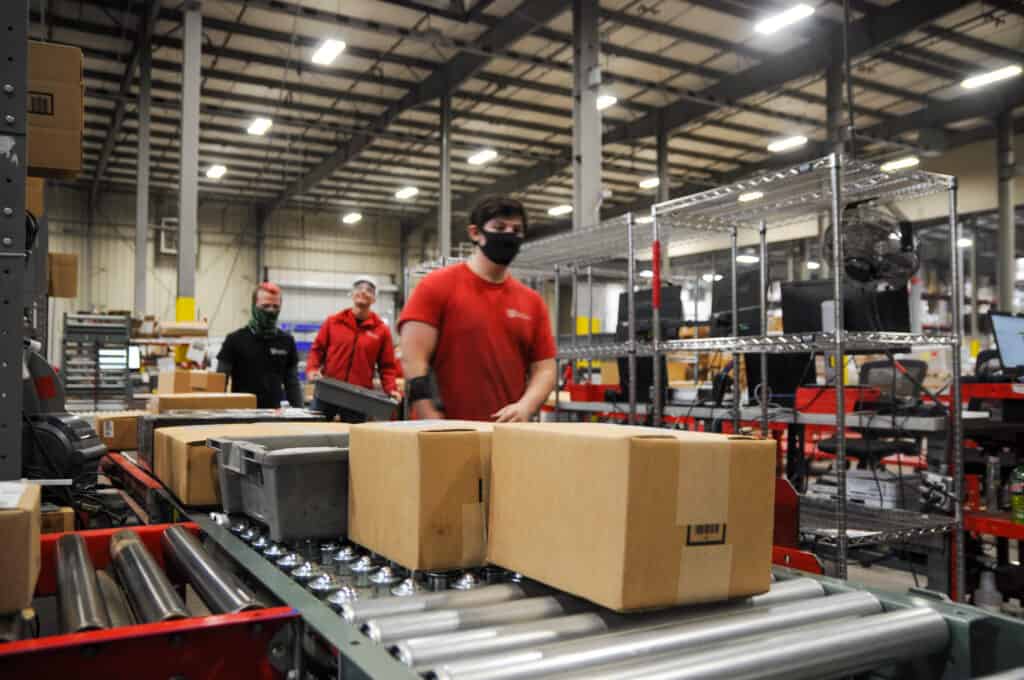Your faucet is leaking, but you’re not sure where. You’ve got a wrench in one hand and a gasket in another, but you just can’t figure out why the water is pooling on the bottom of the cabinet. If you can’t identify the leak’s source, all the tools and spare parts in the world won’t plug that leak. That’s a good analogy for what happens to many eCommerce sites. Your eCommerce store is losing money. The cause could be your site design, your returns policy, or your eCommerce fulfillment operations. You need to figure out the source of the leak to be able to fix it.

To figure out how and why your site isn’t bringing in the profit you’re expecting, you need to know where to look. After all, if there are holes in the bucket, there’s no use in spending your time and capital adding more water.
We’ve put together a list of some of the biggest “leaks” in the eCommerce industry. These are the right places to start when trying to solve a profitability problem with your eCommerce store. You will still need to get your hands dirty with some good self-examination and proper analytics to find the real source of the revenue leak on your site. Here’s our guide. And, for the TL;DR version, we’ve included a handy infographic below.
Poor conversion rates
If you have a high ratio of visits to purchases, your problem might be low conversion rates. There can be many reasons for this, from negative customer reviews to an eCommerce store that’s difficult to navigate.
Your site needs to draw in customers and convince them to buy your products. It’s worth investing in some bells and whistles to make your eCommerce shop more appealing.
Tips for improving conversion rates
The first thing to do when you want to increase your conversion rates is a site audit. Use Google Analytics or other tools to understand where and why your visitors are bouncing. Hire a UX professional or ask friends to click around your eCommerce store and tell you what they find challenging. Then fix the problems.
One common website problem is accessibility. Use clear and easy-to-read fonts for your copy. Choose black on white type over color on color. Include alt text and audio wherever possible. Creating an accessible eCommerce store isn’t hard; you just need to add it to your design guidelines.
Consumers might not buy your products if they don’t feel they know enough about them. Make product videos to show each item in action. Video is one of the best tools for online sellers.
Ultimately, the key to gaining new customers is trust. Here are some steps you can take to show your site visitors that you are a trustworthy seller:
- Be transparent. Let people know if items are out of stock or backordered.
- Include real customer reviews, testimonials, and recommendations on your site. Consider embedding Instagram images of your fans showing off your items.
- Include a customer support phone number and chatbot. Let people know you’re ready to help out if they have questions.
- Include security badges and a privacy policy. Customers won’t want to give you their addresses and credit card information if they aren’t sure your site is secure.
Complex or unclear eCommerce store returns policy
Returns are a surprisingly important factor in eCommerce sales. Online orders are returned at a higher rate than in-store purchases. Return rates are highest for apparel items, where fit is an issue. Consumers will often buy multiple sizes with a plan to return some or all of their purchases.
An excellent returns policy will give consumers the confidence to make a purchase. Knowing they can get their money back if it’s not what they expected helps them feel comfortable enough to buy your products sight unseen.
Of course, no one likes returns. But if you make it difficult or expensive for customers to ship products back to you, they are less likely to buy in the first place. Generous returns policies can make or break eCommerce stores.

Tips for fixing your returns policy
Here are some best practices for returns policies.
- Pay for return shipping. If you can’t offer free shipping on returns, split the difference with your customers and keep the cost low.
- Make your return policy visible on your website. Include information on your product pages and your shopping cart.
- Keep your policy simple. Explain it with visuals, bullet points, and icons rather than paragraphs of dense text.
- Let customers know what to expect with returns. For example, it might take longer to process returns during COVID. Customers will understand if you give them advance notice.
- Extend the time for making returns. Let your customers fully try out the product and still return it if it doesn’t work. That will give them the confidence to make a purchase.
Slow or expensive shipping
Online shoppers love the convenience of shopping on their sofas, but they hate to pay for shipping. High shipping costs are one of the top reasons that people abandon shopping carts. On the other hand, free shipping is a powerful incentive to buy, if you can afford to offer it.
Long shipping times can also be a deterrent to online shopping. Amazon Prime has set the standard to two-day shipping or less. You don’t have to meet Amazon’s speed standard, but the closer you can come to it, the better.
At the same time, eCommerce shipping costs are the biggest component of your fulfillment costs. You need to keep costs down to maintain your profit margins.

Tips to reduce shipping costs
There are several ways to reduce your shipping costs. You can negotiate lower shipping rates with your carrier if you’re a volume shipper. Using the carrier’s packaging can reduce special handling fees.
To reduce lost sales because of long delivery times, offer expedited shipping options. Also, consider warehouse locations for national fulfillment when you choose your 3PL.
Working with a 3PL can also bring your shipping costs down. For example, Red Stag Fulfillment is a high-volume shipper. While you might not ship enough to negotiate special rates with carriers, we do. And we can pass lower shipping costs on to our clients.
We also work with our clients who ship large or bulky items to reduce their dimensional weight and oversize charges. We do this through a combination of careful packaging and negotiating lower DIM factors.
Using a 3PL can also help you reduce delivery times. By choosing order fulfillment centers that are strategically located, you can reach your customers more quickly. For instance, by placing inventory in Red Stag Fulfillment’s Knoxville, TN, and Salt Lake City, UT, warehouses, you can reach 97% of US addresses in two days or less.
If high shipping costs are eating into your sales or profit margins, ask your 3PL for help. Think of your fulfillment center as your business partner, and your business will thrive.
High credit card processing fees
Payment processors take a bite out of every online transaction. In most cases, fees range between 2% and 3%. Some payment processors also charge a per-transaction fee of around $0.30.
Three percent doesn’t sound like a lot. However, every bit counts when you are trying to squeeze a profit from your eCommerce store.
Let’s imagine you sell a product for $24.00. You buy it wholesale for $12.00 and mark it up 100%. Out of the remaining $12.00, 10% goes to inbound shipping from your supplier. Another third goes to overhead. That pays for the admin expenses of running a business, including rent, licenses, and labor, to name a few. Warehousing and fulfillment take another 10%. You offer free shipping, which costs $3.10 for this item. That brings your profit down to $2.50.
$12.00 gross profit -$1.20 inbound shipping – $4.00 overhead – $1.20 warehousing and fulfillment – $3.10 free shipping = $2.50 net profit
If your credit card processor charges you 2.5% of the $24.00 purchase price plus $0.30, that totals $0.90, or more than a third of your net profit going to payment processing; now your net is just $1.60. For orders where you have to add sales taxes, you’ll pay a percentage of the tax amount to the credit card processor, bumping the fee up further.
Fortunately, there are ways to reduce this eCommerce store profit leak.
Tips to reduce your payment processing costs
Shop around to find the credit card processor that can offer you the lowest rates. If a service like PayPal has lower rates, feature the PayPal button prominently at checkout. Consider the per-transaction fees as well as the percentage charged on the total sale.
Abandoned shopping carts
There are as many reasons for shopping cart abandonment as there are consumers. Some people may put items in the cart to check out shipping costs, even if they aren’t ready to buy now. Others are shopping for fun, with little intention of buying.
Sometimes, however, customers were ready to buy, but something about your shopping cart scared them off. Here are some of the top reasons people leave without buying.
- Shipping costs too much.
- Delivery will take too long.
- Shipping costs and delivery times aren’t transparent.
- Unexpected fees at checkout.
- The shopping cart is laid out poorly and is hard to understand.
- Checkout is complicated, leading the customer to give up.
- The customer is distracted by visual elements that take them away from your checkout page.
- You don’t offer a guest checkout option.
- The customer doesn’t feel your cart is secure.
You can’t completely eliminate abandoned shopping carts from your eCommerce store. However, you can reduce their number by making a few tweaks to your checkout.

Tips to mitigate shopping cart abandonment in your eCommerce store
To keep people from abandoning their shopping carts, keep your checkout process as simple and frictionless as possible. Amazon’s one-click button is perhaps the best example of a seamless checkout. You can offer your own version by storing information from returning customers. They can purchase with minimal clicks.
Make sure your security badges are prominently displayed in your shopping cart. That lets shoppers know their credit card information is secure.
See the above section on shipping costs and delivery times for tips for cheaper, faster shipping.
Finally, use analytics to gain insight into your customers’ journeys through your website. This will show you where consumers drop off. You can tweak that page or process until it stops being a barrier to completed sales.
Keep your profits up with regular audits
Reviewing your eCommerce store to figure out where it’s leaking profits is not a one-time exercise. Conduct annual audits to see where you can improve. Make sure your site is up to date with the latest technology. Revise layouts to work better on mobile.
And, of course, if you feel your profits slipping, do a spot audit to find the cause. Get help from your order fulfillment company. As fulfillment professionals, they see it all. They can help you identify ways to improve your packaging, shipping, and inventory management. At Red Stag Fulfillment, we consider our clients our business partners. We want you to succeed. Give us a shout if you’d like to chat about your eCommerce store.






